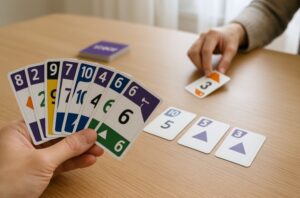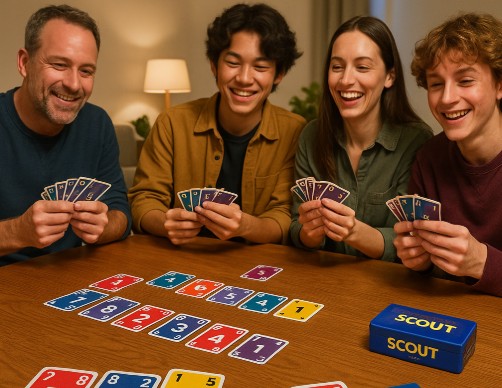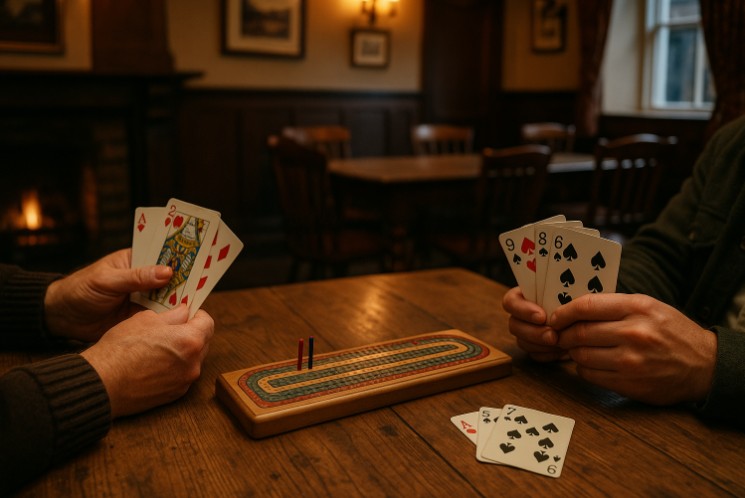The Scout card game is a modern and strategic card game from Oink Games that combines clever mechanics, fast-paced rounds, and minimal setup to create a unique gameplay experience.
Gaining popularity across board game cafes and home game nights in the UK, Scout stands out due to its dual-use cards and strict hand management. This guide explains how to play Scout, outlines the rules, and provides tips to help you get started and sharpen your strategy.
What Is The Scout Card Game?

Scout is a ladder-climbing card game created by Kei Kajino and published by Oink Games. It features a minimalist design but introduces a highly original concept: each card has two values, and players cannot rearrange the cards in their hand after selecting its orientation. This single rule sets the tone for the game’s strategy and tactics.
Players take turns playing higher combinations or scouting from opponents’ plays, with the objective of either emptying their hand or scoring more points by the end of a round.
The simplicity of rules paired with tactical depth has helped Scout gain significant attention from board game communities.
The most innovative element of the Scout card game is the dual-number card system. Each card is usable in two orientations. Before the round starts, players choose which side to use and keep their hand fixed in that order for the entire round. This demands foresight and calculation from the first moment of the game.
How Do You Set Up The Scout Card Game?
Setting up the Scout card game is fast and efficient. The components are compact and ideal for travel or casual settings.
Game Components:
- 45 double-numbered cards
- 5 player identity markers
- 1 first player token
- Scout tokens for scoring
Setup Process:
- Shuffle the card deck thoroughly.
- Deal cards to each player based on total player count:
- 2 players: 10 cards
- 3 players: 9 cards
- 4–5 players: 8 cards
- Players review their hands and choose one orientation (top or bottom number). This decision is final for the round, and cards must remain in that order.
- Return unused cards to the box.
- Distribute Scout tokens to each player and set aside a scorepad if needed.
Once the setup is complete, the starting player is chosen randomly or by passing the first player token clockwise each round.
What Are The Basic Rules Of The Scout Card Game?

The Scout card game blends simplicity with layered strategy. At its core, players take turns attempting to either play a stronger set of cards than the previous player or improve their own hand by scouting a card. The fixed order of the hand and the dual-number cards make the basic gameplay surprisingly rich and engaging.
Objective
The primary goal is to earn the highest number of points across several rounds by either:
- Playing combinations of cards that can’t be beaten
- Forcing other players to Scout from your plays
- Emptying your hand before other players do
Each turn presents a decision point: whether to show a stronger combination, take a card to enhance your hand, or strategically bide your time for a winning move.
Turn Structure
Each player, on their turn, must choose one of the following actions:
1. Show (Play A Combination)
This involves playing a set of one or more cards from your hand. The combination must be stronger than the one currently on the table. The types of valid combinations are:
- Single card – Just one card from your hand
- Group – Two or more cards with the same number, in sequence (cards must be adjacent in your hand due to the no-reordering rule)
- Run – Two or more consecutive numbers, also appearing in the current hand order
For example, if you have three 5s adjacent in your hand (top number), you may play them as a group. If you have 3-4-5 in sequential order, they can be played as a run.
To be valid, your play must beat the currently shown combination in both type and strength. The general rule is:
- A run of more cards beats a shorter run
- If the length is equal, the highest top card in the set wins
- A run always beats a group of the same length (e.g., a 3-card run beats a 3-card group)
2. Scout (Take A Card)
If you cannot beat the combination on the table or if you choose not to you may Scout one card from the currently shown combination. This action allows you to improve your hand for future turns.
Rules for Scouting:
- You must take one card from either end of the shown combination
- You may insert this card anywhere in your hand, but you still cannot rearrange the rest of your hand
- You may choose to flip the card to use its alternate number before inserting it
- The player from whom you scouted gains one Scout token (worth 1 point at the end of the round)
Scouting often becomes a key part of mid-game strategy, enabling you to build potential combinations for later plays.
3. Scout & Show (Once Per Round)
Each player is allowed to use the Scout & Show action once per round. This lets you Scout a card from a combination and immediately use it (along with other cards from your hand) to play a valid, stronger combination.
Key details:
- The scouted card must be used in the combination you play immediately
- It’s the only time in the round you can Scout and Show in a single turn
- Timing this action well can turn the momentum in your favour
Players often reserve this move for crucial turning points—such as when an opponent has played a long or high-value combination that you wouldn’t be able to beat otherwise.
Ending A Round
A round ends when either of the following occurs:
- A player successfully empties their hand
- All other players Scout on the same turn, allowing the last played combination to stand unbeaten
When a round ends, players calculate their scores based on the number of Scout tokens collected and cards remaining in their hand.
Player Turn Options
| Action | Description | When To Use |
| Show | Play a stronger combination than the current one on the table | When you can beat the set and gain control |
| Scout | Take one card from either end of the current play and insert into your hand | When you can’t or choose not to beat the current set |
| Scout & Show | Scout a card and immediately play a stronger combination | Use once per round for a strategic surprise or reversal |
Key Restrictions
- Card Order: Once your hand orientation (top or bottom number) is selected at the start, the order of the cards must remain fixed. You can only add cards via scouting.
- Combos Must Be Adjacent: Groups and runs must use cards next to each other in your hand; you cannot jump over cards.
- Scout Limitations: You may only take from the leftmost or rightmost end of the previously played combination.
This combination of rules ensures that the game remains fair, strategic, and engaging while offering a unique challenge with each hand dealt.
How Does Scoring Work In Scout?
Scoring occurs at the end of each round and serves as the game’s main progress tracker. Points are given based on player performance and efficient use of cards.
Scoring Rules:
- The player who empties their hand receives a bonus for each turn where their combination went unbeaten.
- Each Scout token earned during the round is worth 1 point.
- All other players subtract 1 point for each card left in their hand.
Scoring Table Example:
| Player | Cards Left | Scout Tokens | Unbeaten Plays | Total Score |
| Player A | 0 | 2 | 3 | 5 |
| Player B | 3 | 0 | 0 | -3 |
| Player C | 1 | 1 | 1 | 1 |
Points are tracked over multiple rounds. The player with the highest cumulative score at the end of the game is declared the winner.
What Strategies Can Help You Win At Scout?

Winning at the Scout card game is not just about luck it’s about making smart, calculated decisions throughout the round. Since the rules limit your ability to rearrange your hand and each card has two potential values, your strategy must begin even before the first card is played.
Every action in Scout from choosing your hand orientation to deciding when to use Scout & Show has consequences that affect your long-term success.
Here’s a detailed look at the most effective strategies to improve your chances of winning:
Evaluate Both Sides of Your Hand Before Locking It In
At the start of each round, once the cards are dealt, you must choose whether to play them as they are (top side) or flip the entire hand and use the bottom side. This decision is irreversible for the round and will influence the rest of your game.
Tips for evaluating:
- Look for potential runs (consecutive numbers) and clusters of the same number
- See which orientation offers more combinations using adjacent cards
- Choose the side that provides the most flexibility and long-term potential
Choosing the right orientation is often the difference between building multiple strong plays and getting stuck with an unusable hand.
Prioritise Building Sequences Over Groups
While both runs and groups are legal plays in Scout, sequences generally provide a tactical advantage. A sequence of the same length will always beat a group, even if the group contains higher numbers.
Why runs are stronger:
- They are harder to build under hand-order restrictions
- They outclass groups of the same size
- They allow more flexibility when scouting new cards
If you can build a 3-card run early on, it gives you a better chance of winning the lead and scoring points from unbeaten plays.
Don’t Play Your Best Combination Too Early
A common mistake is to use your strongest play as soon as you can. This might give you temporary control of the table but leaves you exposed in later rounds when opponents may overtake you.
Instead:
- Use mid-level combinations to maintain control
- Hold onto high-value sets or longer runs for crucial moments
- Save strong plays to block an opponent from winning a round
Maintaining a balanced hand with backup options increases your staying power in the round.
Use The Scout Action Proactively
Scouting is often seen as a fallback, but experienced players use it as a strategic tool. Scouting allows you to improve your hand, create new combos, and control the game flow without risking a poor play.
Smart scouting includes:
- Taking cards that help complete or extend a run
- Blocking a powerful set from staying on the table unchallenged
- Choosing the best time to Scout instead of wasting a weak play
Also, remember that when others scout from you, you gain points so making attractive plays can work in your favour.
Time Your Scout & Show Move Carefully
You can only use Scout & Show once per round, so the timing of this action is critical. It’s best used when you can:
- Break a strong streak set by another player
- Seize control at a critical point in the round
- Convert a scouted card immediately into a winning combination
Scout & Show can act as a defensive manoeuvre or a game-winning play depending on how and when it’s deployed. Using it too early wastes its potential; too late, and you may never get the right opportunity.
Observe Your Opponents Closely
Tracking what your opponents are playing and scouting helps you anticipate their next move. With experience, you’ll be able to infer the likely structure of their hands and make more informed decisions.
Watch for:
- Repeated numbers (suggesting they’re building a group)
- Shorter sequences (they may be running low on options)
- Frequent use of Scout (could mean they’re stalling or rebuilding)
This kind of observation helps you block strategic plays, avoid unnecessary risks, and target your Scout actions more effectively.
Balance Risk And Reward
Sometimes taking a risk such as playing a borderline-strong combination — is worth it if you can force other players to Scout and gain points. At other times, it’s safer to build your hand and wait for an opening.
Know when to:
- Push for a win by exhausting your hand
- Slow down and build better options through scouting
- Let another player take control so you can strike later with Scout & Show
Every decision should be based on what’s been played, what’s likely remaining, and how many cards are in each player’s hand.
Use Scout Tokens As A Tactical Indicator
Each Scout token earned means another player scouted from your play. This is not just a point it also gives you insight into the strength of your play and the potential state of your opponents’ hands.
- If multiple players scout from you in a round, you’re likely in a strong position
- If no one scouts, your play may be too weak to hold the lead
- If everyone scouts on the same turn, you immediately score a point for an unbeaten set
Keep track of your token tally it’s a passive but important metric for judging your influence in the round.
How Does Scout Compare To Other Card Games?
Scout holds a unique position in the card game landscape. While it shares ladder-climbing mechanics with traditional games like President or Tichu, its restriction on card order and dual-number system are rare and engaging.
Comparison Table:
| Feature | Scout | Uno | The Mind | Tichu |
| Rearranging Cards Allowed | No | Yes | N/A | Yes |
| Dual-Purpose Cards | Yes | No | No | No |
| Sequence-Based Combos | Yes | No | No | Yes |
| Learning Curve | Low | Very Low | Low | High |
| Strategic Depth | Medium-High | Low | Medium | High |
Scout sits between the worlds of casual and strategic gaming, making it appealing to a broad spectrum of players. It’s easy to learn yet difficult to master, thanks to the limitations that challenge even seasoned players.
Who Should Play The Scout Card Game?

The Scout card game is well-suited to different types of players and play environments. Whether you’re a casual gamer or someone with a keen strategic mind, Scout has something to offer.
Ideal For:
- Families seeking an accessible and quick-to-learn game
- Board game enthusiasts who enjoy innovative mechanics
- Social gamers looking for compact games for group play
- Travellers who need a lightweight, portable card game
- Strategy lovers who enjoy analysing hand structure and decision timing
The game’s flexibility in player count and its short play time make it a versatile addition to any gaming session.
What Are Some Common Mistakes To Avoid In Scout?
Despite its streamlined rules, players often make fundamental mistakes that reduce their effectiveness in the game. Recognising and avoiding these errors is key to improving your performance.
Common Pitfalls:
- Rearranging Your Hand: Once the orientation is chosen, reordering cards is not allowed. This breaks the game’s challenge.
- Ignoring Scout Opportunities: Always consider how taking a card could create future combos.
- Wasting Your Scout & Show Move: Use it when it can turn a losing hand into a winning opportunity.
- Failing To Track Opponents: Watch which cards are being played and which combinations repeat.
- Misjudging Combination Strength: Understand how sequence length can overcome value in certain scenarios.
Awareness of these mistakes helps players build confidence and improve their tactical approach over repeated sessions.
Conclusion
The Scout card game stands out for its clever design, unique hand mechanics, and satisfying mix of simplicity and depth.
It offers fast, engaging gameplay that appeals to a wide variety of players, from families to seasoned card game veterans. Whether you’re looking for a quick filler or a thoughtful strategic duel, Scout deserves a spot in your collection.
FAQs
Is Scout suitable for children under 10?
Yes, it’s designed for ages 9 and up and is accessible for younger players with some guidance.
Can Scout be played with two players?
Yes, it plays well with two, though the game is more competitive with 3–5 players.
Are there expansions or versions of Scout?
Currently, Scout is a standalone game with no official expansions.
How long does a full game of Scout take?
A single round takes about 20 minutes. A full game of multiple rounds can last 45–60 minutes.
Do card sleeves affect gameplay in Scout?
No, but sleeving may help preserve the cards’ print quality and longevity.
What happens if a player can’t make a move?
They must Scout if unable or unwilling to beat the previous set.
Can Scout be played digitally or online?
As of now, no official digital version exists, though fans have created unofficial versions on tabletop simulators.







